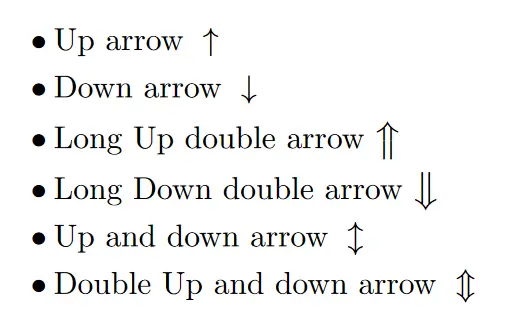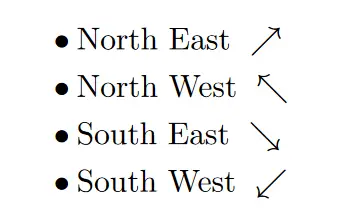This article aims to show you the simplest and easiest way to write the arrow symbols in LaTeX.
It is pretty common to encounter arrows in multiple presentations, LaTeX is familiar with arrows too, that is why today you will learn how to insert arrows in your documents.
Table of Contents
Arrow Symbol in LaTex
I would like to start by saying, there are A LOT of arrows, different shapes, sizes, forms, thickness, etc. Thus we will focus on the most common arrows you may end up using on a daily basis with LaTeX.
Most of the time the Arrow Symbols can be used in equations, text, tables and so on, but always using the math mode. For example
\documentclass{article}
\begin{document}
$$f(x) \rightarrow mx + b$$
$$x \Rightarrow a + f(b)$$
\end{document}

Now to create any LaTeX arrow symbol in LaTeX you have the option to not use packages, LaTeX has some built-in commands for arrow symbols. You will see some of the most common LaTeX commands.
Vertical Arrow Symbols
Starting with the vertical direction for the arrows, the following table contains the commands and some examples.
| Arrow Style | LaTeX Command |
| Up | \uparrow |
| Up double | \Uparrow |
| Down | \downarrow |
| Down double | \Downarrow |
| Up and down | \updownarrow |
| Double up and down | \Updownarrow |
\documentclass{article}
\begin{document}
\begin{align*}
&\bullet \text{Up arrow} \,\, \uparrow \\
&\bullet \text{Down arrow} \,\, \downarrow \\
&\bullet \text{Long Up double arrow} \,\, \big\Uparrow \\
&\bullet \text{Long Down double arrow} \,\, \big\Downarrow \\
&\bullet \text{Up and down arrow} \,\, \updownarrow \\
&\bullet \text{Double Up and down arrow} \,\, \Updownarrow
\end{align*}
\end{document}
The \big command you see in before some commands, is to make long arrows, and \bullet to create the black dot; this code gives the output

Left and Right Arrow
Moving on to horizontal arrows, either right or left arrow, we have left and right for most of the arrows.
| Arrow Style | LaTeX Command |
| Left | \leftarrow |
| Double left | \Leftarrow |
| Right | \rightarrow |
| Double right | \Rightarrow |
| Left and Right | \leftrightarrow |
| Double Left and Right | \Leftrightarrow |
| If and only If | \Leftrightarrow |
\documentclass{article}
\begin{document}
\begin{align*}
&\bullet \text{Left arrow} \,\, \leftarrow \\
&\bullet \text{Double Left arrow} \,\, \Longleftarrow \\
&\bullet \text{Right arrow} \,\, \longrightarrow \\
&\bullet \text{Double Right arrow} \,\, \Longrightarrow \\
&\bullet \text{Left and Right arrow} \,\, \leftrightarrow \\
&\bullet \text{If and only if arrow} \,\, \iff \, \text{or}\,\Longleftrightarrow
\end{align*}
\end{document}

The last arrow has two commands either \iff or \Longleftrightarrow. Please notice that if you want to create a longer symbol depending on whether you are using single or double arrow, for the longer single arrow you need \long[left or right]arrow, and for the longer double arrow \Long[left or right]arrow.
Diagonal Arrow Symbols
Surprisingly LaTeX has diagonal and directional symbols integrated, the commands are quite obvious if you are familiar with the cardinal points.
| Arrow Style | LaTeX Command |
| North East | \nearrow |
| North WesT | \nwarrow |
| South East | \searrow |
| South West | \swarrow |
\begin{document}
\begin{align*}
&\bullet \text{North East} \,\, \nearrow \\
&\bullet \text{North West} \,\, \nwarrow \\
&\bullet \text{South East} \,\, \searrow \\
&\bullet \text{South West} \,\, \swarrow
\end{align*}
\end{document}

More Arrows Symbols with packages
There is a method if you want to write the arrows symbol in text mode, loading the textcomp package. The commands are just the same but you need to add \text right before the name of the arrow, \text[left, right, up, down]arrow.
For example
\usepackage{textcomp}
\begin{document}
\item Up arrow \textuparrow or down arrow \textdownarrow
\item Left arrow \textleftarrow or right arrow \textrightarrow
\end{document}

These are the most common arrows symbols you may encounter and will write, but remember, there is an entire universe of arrows out there in LaTeX.
I hope this post was helpful in guiding you in LaTeX, and as always keep writing in LaTeX.
All the images were created in LaTeX by the author.
Further Reading
LaTex Tutorial on Symbols
- How To Create A Cross Product Symbol In LaTeX
- How to create a hat symbol in LaTeX?
- How to create a prime symbol in LaTeX?
- How to create an absolute value symbol in LaTeX?
- How to create an approximate symbol in LaTeX?
- How to create an intersection symbol in LaTeX?
- How to create the empty set symbol in LaTeX?
- How to write a degree symbol in LaTeX?
- How to write a dot product in LaTeX?
- How to Write a Greater Than Symbol in LaTeX?
- How to write a norm symbol in LaTeX?
- How to write A Plus-Minus Symbol in LaTeX
- How to write a proportional to symbol in LaTeX?
- How to write a real number symbol in LaTeX?
- How to write a tilde symbol in LaTeX?
- How to write a union symbol in LaTeX?
- How to write a vector in LaTeX?
- How to write an infinity symbol in LaTeX?
- How to write bold text in LaTeX?
- How To Write Dots Symbols In LaTeX?
- How to write the Degree celsius symbol in LaTeX?
- How to write the equal or not equal symbol in LaTeX?
- How to write the Euro symbol in LaTeX?
- How to write the floor symbol in LaTeX?
- How to write the gradient operator symbol in LaTeX
- How To Write The Greater Than Or Equal To Symbol In LaTeX?
- How to write the integer number symbol in LaTeX?
- How to write the less than symbol in LaTeX?
- How to write the Natural numbers symbol in LaTeX?
- How to write the parallel symbol in LaTeX?
- How to write the percent symbol in LaTeX?
- How to write the square root symbol in LaTeX?
- How To Write The Symbol For A Subset In LaTeX?
- How to write the symbol for therefore in LaTeX?
- How to write with the mathbb in LaTeX?


